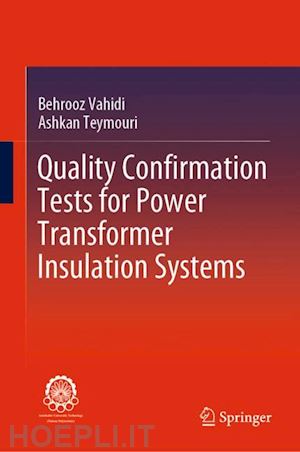
Questo prodotto usufruisce delle SPEDIZIONI GRATIS
selezionando l'opzione Corriere Veloce in fase di ordine.
Pagabile anche con Carta della cultura giovani e del merito, 18App Bonus Cultura e Carta del Docente
Contents
Chapter 1: Unused Mineral Insulating Oil
1.1..... Introduction. 21.2..... Mineral Oil 2
1.3..... Classification of mineral oil based on application 3
1.3.1...... Transformers oil 4
1.3.2...... Switchgear oil in low temperatures 4
1.4..... Additives. 9
1.5..... Special cases. 11
1.6..... Analysis of potentially corrosive sulphur 11
1.7..... Oil contamination 12
References. 12
Chapter 2: In-service Mineral Insulating Oil
2.1..... Introduction. 142.2..... Oil monitoring and purification 14
2.3..... Oil ageing and degradation 15
2.4..... Oil tests. 15
2.4.1...... Color and appearance 15
2.4.2...... Breakdown voltage 16
2.4.3...... Water content 162.4.4...... Water in the insulation system 17
2.4.5...... Acidity. 21
2.4.6...... Dielectric dissipation factor (DDF) and resistivity 212.4.7...... Additives and oxidation stability 24
2.4.8...... Sludge and sediment 25
2.4.9...... Interfacial tension 25
2.4.10.... Particle content 25
2.4.11.... Flash point 27
2.4.12.... Compatibility of insulating oil 272.4.13.... Pour point 28
2.4.14.... Density. 28
2.4.15.... Viscosity. 282.4.16.... PCB.. 28
2.4.17.... Corrosive sulphur 28
2.4.18.... Dibenzyl disulphides (DBDS) 29
2.4.19.... Passivators. 29
2.5..... In-service oil monitoring 30
2.5.1...... Uninhibited oil monitoring 30
2.5.2...... Inhibited oil monitoring 30
2.6..... Time schedule of sampling and testing in-service oil 31
2.7..... Available on-site tests 31
2.8..... Classification of operating oil 32
2.9..... Corrective actions 32
2.10... Purification. 32
2.10.1.... Physical purification 33
2.10.2.... Chemical purification (refinement) 35
2.10.3.... Substitution of additives 36
2.10.4.... Cleaning PCB contaminated oil 36
2.11... Replacing oil in electrical equipment 36
2.12... Adding passivators 37
2.13... Determining water concentration in the oil 38
References. 39
Chapter 3: Chemical Indicators
3.1..... Introduction. 42
3.2..... Insulation paper life determination 42
3.3..... Cellulose. 43
3.4..... Cellulose molecular structure 44
3.5..... Cellulosic insulation 44
3.6..... Degree of polymerization 46
3.7..... Oil impregnated insulation paper 47
3.8..... Ageing of oil impregnated insulation paper 47
3.9..... Ageing mechanism.. 48
3.9.1...... Pyrolysis. 49
3.9.2...... Hydrolysis. 503.9.3...... Oxidation. 51
3.10... Influence from acids 52
3.11... Ageing of oil 52
3.12... Oil oxidation. 53
3.13... Degradation products in oil impregnated insulation systems 53
3.14... Degradation products from cellulosic insulation 54
3.14.1.... Water 54
3.14.2.... Acids. 54
3.14.3.... Furans. 543.14.4.... Carbon oxides 55
3.14.5.... Hydrocarbons 55
3.15... Degradation products of oil 56
3.15.1.... Acids. 56
3.15.2.... Sludge. 56
3.16... Chemical indicators 56
3.17... Furan compounds 57
3.17.1.... Furans origin. 57
3.18... The relationship between DP and furans 57
3.19... Stability. 58
3.20... Furans disadvantages 59
3.21... CO2 and CO.. 59
3.22... The combination of CO2/CO ratio and 2-furfural 60
3.23... Methanol 61
References. 69
Chapter 4: Dissolved Gas Analysis (DGA)
4.1..... Introduction. 744.2..... Total flammable dissolved gas in the transformer 76
4.3..... Allowable concentration of gases in a transformer 76
4.4..... Gas ratio methods 77
4.4.1...... Dürrenberg method 77
4.4.2...... Rogers ratio. 78
4.4.3...... IEC Ratio method 794.5..... Duval triangle method 80
4.6..... Detection of partial discharge using DGA 82
4.7..... Impact of DGA accuracy on fault detection 82
References. 83
Chapter 5: Other Tests
5.1..... Introduction. 86
5.2..... Partial discharge (PD) 86
5.2.1...... Corona discharge 87
5.2.2...... Surface discharge 87
5.2.3...... Discharge in composite insulation materials 88
5.2.4...... Electric discharge in cavities 885.2.5...... Electric treeing 89
5.3..... Partial discharge measurement 90
5.4..... Insulation monitoring by PD measurement 91
5.5..... Comparison of electrical and audio detection methods 94
5.6..... Partial discharge formation in transformers 95
5.7..... Dielectric response analysis 95
5.8..... Polarization. 96
5.9..... Polarization and depolarization currents 98
5.10... Insulation spectroscopy in time domain 99
5.11... FDS test 102
5.12... Returning voltage method 104
5.13... Isothermal relaxation current 106
5.14... Frequency response analysis (FRA) 107
5.15... Frequency response analysis theory 108
5.16... Application of FRA in power transformers 109
5.17... FRA test features 109
5.18... Frequency response measurement methods 110
5.18.1.... Swept frequency method (SFM) 110
5.18.2 Low voltage impulse methods (LVI) 112
5.19... Comparison of LVI and SFM methods 1125.20... Detectable defects by FRA 113
References. 114
Subject Index. 117











Il sito utilizza cookie ed altri strumenti di tracciamento che raccolgono informazioni dal dispositivo dell’utente. Oltre ai cookie tecnici ed analitici aggregati, strettamente necessari per il funzionamento di questo sito web, previo consenso dell’utente possono essere installati cookie di profilazione e marketing e cookie dei social media. Cliccando su “Accetto tutti i cookie” saranno attivate tutte le categorie di cookie. Per accettare solo deterninate categorie di cookie, cliccare invece su “Impostazioni cookie”. Chiudendo il banner o continuando a navigare saranno installati solo cookie tecnici. Per maggiori dettagli, consultare la Cookie Policy.